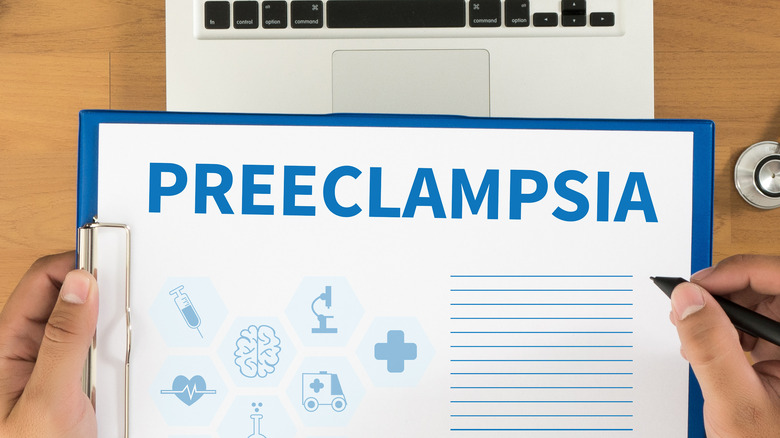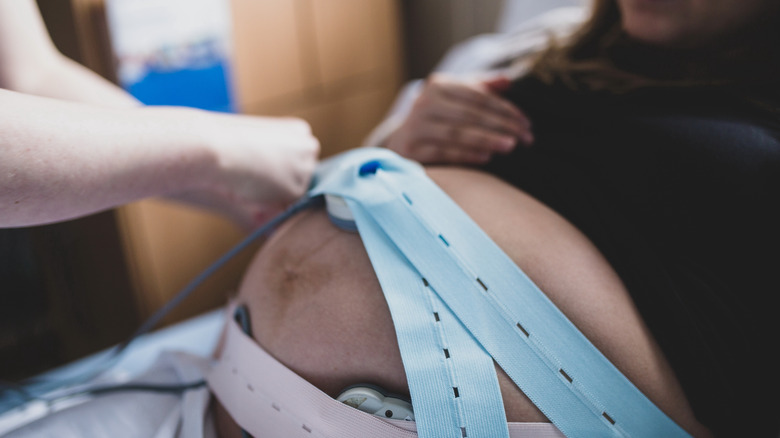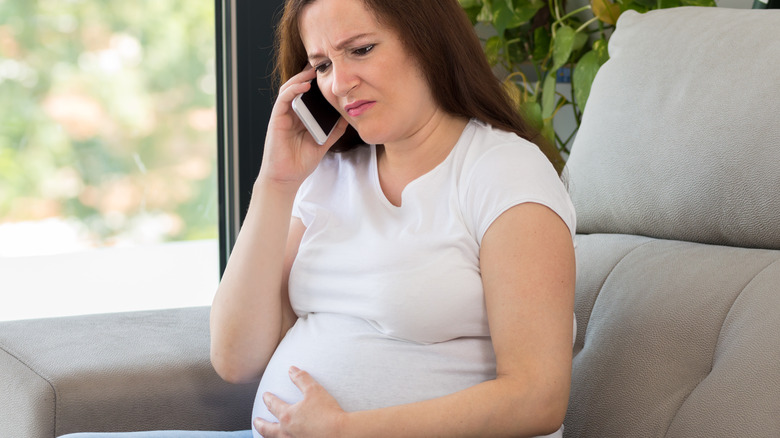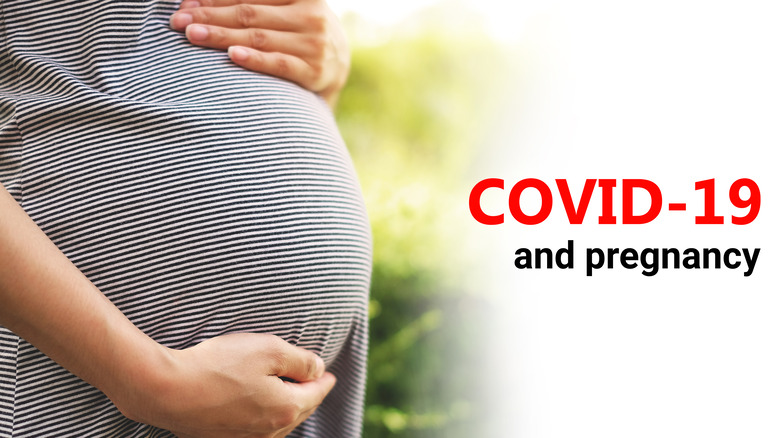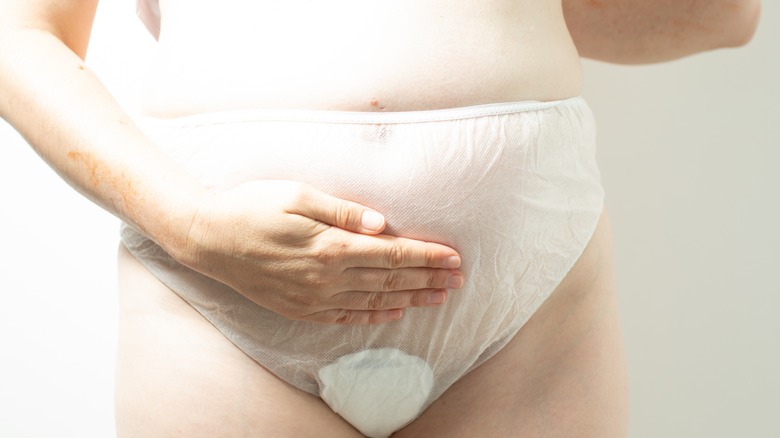Everything You Need To Know About Preeclampsia
Preeclampsia is a hypertensive condition that typically appears after 20 weeks of pregnancy. Preeclampsia accounts for about 2% to 8% of pregnancy complications worldwide, according to a 2022 study.
You may wonder why your doctor monitors your blood pressure so closely, especially during the last trimester of pregnancy. A rise in blood pressure may be a warning sign that you are developing preeclampsia. In fact, preeclampsia is the cause of 15% of premature births (births that occur before 37 weeks gestation), per the March of Dimes.
Routine prenatal care, early diagnosis, and prompt treatment are required for this disease to have a lower morbidity and mortality rate. Fortunately, with prenatal care, most cases of preeclampsia are mild. Because knowledge is power, knowing and understanding the early warning signs, causes, and whether you are predisposed to developing preeclampsia during your pregnancy is critical. Although there is no surefire way to prevent developing preeclampsia, there may be measures to lower the risk for some people (via Virtua Health).
Causes and risk factors
The exact cause of preeclampsia is unknown, according to Healthline. However, a few potential causes are being investigated, including autoimmune disorders and hereditary factors. WebMD states that some experts attribute preeclampsia to placental abnormalities or a lack of uterine blood flow. While these may be contributing causes, they are not fully understood.
On the other hand, certain risk factors can increase the chances of developing preeclampsia. Several potential risk factors, including family history, are mentioned by the American Pregnancy Association. If your mother or sister had preeclampsia, you might also be more likely to develop it. Because preeclampsia is characterized by increased blood pressure, you should monitor it closely during pregnancy, especially if you have a history of high blood pressure. Furthermore, losing weight before pregnancy is the most effective way to lower the risk of obesity-related risk factors. Even minor weight loss can contribute to a healthier pregnancy. It is critical to discuss risk factors with your healthcare provider because they know your personal health history and can help you understand if you are at increased risk, per the American College of Obstetricians and Gynecologists (ACOG).
Warning signs and symptoms to be aware of
Knowing preeclampsia's warning signs and symptoms will allow you to discuss your concerns with your doctor as soon as possible. ACOG mentions some warning signs you may be unaware of. Initially, you may experience symptoms other than high blood pressure, such as a mild headache that worsens or becomes more persistent. Your vision may become distorted, resulting in spots or fuzziness. Furthermore, you may experience sudden weight gain and increased swelling in your hands and feet.
Some of these warning signs mimic common pregnancy ailments. As a result, if any of these signs appear, particularly if they worsen, you should consult your doctor for a thorough examination.
Throughout the day, it is normal for blood pressure to fluctuate. Most people are unaware that their blood pressure is high until it is checked during a prenatal visit. This is one of the reasons why keeping all prenatal appointments is critical to you and your unborn baby's health. If your blood pressure is higher than 130/80, your doctor may ask you to rest for a few minutes before rechecking it to see if the reading is consistently elevated. You may be required to check your blood pressure at home as an added precaution. Your doctor will also check your urine regularly for the presence of protein, which is another indicator of preeclampsia (via the Centers for Disease Control and Prevention).
How is preeclampsia diagnosed?
Preeclampsia is frequently diagnosed during routine prenatal visits when your healthcare provider checks your blood pressure, urine, and weight gain. For this reason, keeping regular prenatal appointments is crucial. Blood pressure readings of 140/90 or higher taken at least four hours apart are considered abnormal (via the American Pregnancy Association). Similarly, protein in the urine and elevated blood pressure are tell-tale signs of developing preeclampsia.
According to the National Institute of Child Health and Human Development, gestational hypertension is diagnosed when women with normal blood pressure before conception develop high blood pressure without protein in the urine after 20 weeks of pregnancy. This can happen before preeclampsia is diagnosed, so it's essential to be aware of it. Mild preeclampsia is diagnosed when protein is found in the urine along with elevated blood pressure. After being diagnosed with mild preeclampsia, your healthcare provider will closely monitor you for symptoms such as increased blood pressure, higher protein levels in the urine, liver or kidney damage, and frequent headaches or visual disturbances. Any of these additional symptoms could indicate progression to severe preeclampsia. At this point, your healthcare provider may order further tests, such as blood work, ultrasound, a nonstress test, and a physical exam, to confirm the health of both mom and baby. These other tests will assist in developing an appropriate treatment plan.
Complications that can occur with preeclampsia
You should be aware of the many potential complications of preeclampsia. Most complications occur if the initial symptoms are not recognized. Consistent prenatal care will assist you and your healthcare provider in addressing any concerns before they become serious.
Preeclampsia can be fatal to you and your unborn child if left untreated (via the Cleveland Clinic). It is thought to alter the blood supply that feeds the uterus and placenta, which, according to the Mayo Clinic, can make it difficult for the fetus to absorb enough nutrition, oxygen, and blood. As a result, the fetus's development may be affected. Furthermore, preeclampsia increases the risk of placental abruption. This complication can be fatal to both the mother and baby.
Finally, complications from preeclampsia can progress to eclampsia, a potentially fatal condition (per MedlinePlus). Eclampsia can affect the mother's cardiovascular system, kidneys, brain function, and other vital organs. Unfortunately, eclampsia can strike without warning and typically manifests as the onset of seizures. This situation necessitates immediate medical attention.
How is preeclampsia treated?
The disease's severity determines preeclampsia's treatment at the time of diagnosis. According to Cedars Sinai, treatment goals are centered on preserving the mother's health and well-being, ultimately ensuring the baby's survival. If mild preeclampsia is diagnosed, bed rest may be the best treatment if no other symptoms are present.
Your healthcare provider may advise you to increase water consumption and avoid high sodium and processed foods. In addition, you may be asked to monitor your blood pressure at home and keep track of fetal movements. Your provider will schedule frequent appointments to ensure your condition is not worsening (via ACOG). If your symptoms do not worsen, your doctor may suggest inducing labor around 37 weeks. If your symptoms deteriorate, the next step would be hospitalization and medication to stabilize them. If the medicines do not work, the treatment goal shifts to delivering the baby regardless of gestational age.
At this point, you may be given a steroid injection to aid in developing the baby's lungs. Furthermore, Healthline reports that magnesium sulfate will most likely be given to prevent seizures during and 24 hours after delivery. Ultimately, the goal of any treatment plan is a healthy mom and baby.
What you should know about HELLP syndrome
HELLP is an acronym for hemolysis, elevated liver enzymes, and low platelets (via the Preeclampsia Foundation). It is a potentially fatal pregnancy complication that usually manifests itself in the later stages or last trimester of pregnancy, though it can occur after birth. Women who develop preeclampsia or eclampsia are more likely to develop HELLP syndrome. Symptoms can resemble preeclampsia at first, but if you experience chest pain, upper abdominal pain, or a worsening of any symptoms, you should seek emergency medical attention. If HELLP syndrome is diagnosed, the priority will be stabilizing the mother, followed by an emergency baby delivery. The baby's health will be affected by his or her gestational age at birth, complications, and birth weight.
The Preeclampsia Foundation also states that if the baby weighs at least two pounds at birth, he or she will have the same health outcomes as any non-HELLP baby of the same size. Long-term health concerns are minimal in this situation. If the baby weighs under two pounds at birth, he or she may require additional care and a more extended stay in the NICU. Long-term complications may not be completely obvious in this case.
That said, it may be reassuring to know that HELLP syndrome is rare, occurring in only 0.1% to 1% of pregnancies (via the Cleveland Clinic).
Could exercise be the answer to reducing the risk of preeclampsia?
According to the CDC, high blood pressure is common during pregnancy. You've probably heard that exercise is important for a healthy lifestyle, but could it help reduce your risk of developing high blood pressure or preeclampsia during pregnancy?
A 2022 research study published in the Journal of Clinical Medicine reported that approximately 10%-15% of pregnancies are affected by high blood pressure, which can progress to preeclampsia. This study reviewed the benefits of supervised exercise programs versus unsupervised or no exercise during pregnancy. According to the study, those who exercised under supervision had a whopping 46% lower risk of developing a hypertensive disease during pregnancy than those who did not exercise or exercised unsupervised. Similarly, the American Heart Association (AHA) states that physical activity in general, beginning in the initial trimester of pregnancy, reduces the risk of preeclampsia significantly compared to inactive women.
Being physically active during pregnancy can boost your energy, improve your mood, and help you sleep better (via the Mayo Clinic). These are just a few additional advantages physical activity can provide. You should consult your doctor about what is appropriate and safe for you.
Low-dose aspirin and preeclampsia prevention
Based on certain risk factors identified by your obstetric provider, there is strong evidence to support the use of low-dose (81 milligrams) aspirin in pregnant women with certain risk factors for developing preeclampsia. To determine if this prophylactic medication is necessary, adequate screening during the first trimester of pregnancy is essential (via ACOG).
According to the Journal of the American Medical Association (JAMA), beginning aspirin therapy before 16 weeks of pregnancy is more advantageous. Prior medical history of high blood pressure or preeclampsia during a previous pregnancy are only a few risk factors considered for this treatment. Diabetes, autoimmune diseases, a high body mass index (BMI), age, and socioeconomic status are other factors considered. More research is being conducted to determine whether low-dose aspirin treatment is beneficial to prescribe universally due to the various risk factors that can be considered. Your healthcare professional will identify your specific risk factors and balance the benefits and disadvantages of aspirin use.
Can new blood tests determine the risk of developing preeclampsia?
Diagnosing preeclampsia in the early stages can be challenging. Most providers rely on noticeable signs that fluctuate, such as blood pressure and urinalysis. However, many women can be placed on bed rest or even hospitalized as a precaution, when they may not need to be. Could there be a more accurate way to rule out preeclampsia with specific blood tests?
The Preeclampsia Foundation summarized a study that looked at specific pregnancy markers to determine if a woman was at risk of developing preeclampsia within a few weeks of the blood test. According to the study, women with a negative ratio score have a 97% chance of not developing preeclampsia in the upcoming weeks. This study is significant, as it could help reduce unnecessary hospitalizations and office visits.
On the other hand, studies have been conducted to assist providers in determining whether early delivery is required due to preeclampsia. Healthcare providers consider the risks to the mother of continuing the pregnancy and the risks to the unborn child of premature delivery. The researchers focused on the placental growth factor because it is thought to be lower in pregnant women who develop preeclampsia. Unfortunately, the study (via the British Medical Journal) had no clinically significant impact on determining the mother's or unborn baby's outcome. As a result, it is not recommended for use in clinical care at this time. More research on blood tests for preeclampsia is needed, but the future looks promising in terms of improved diagnostic tools.
Does contracting Covid-19 during pregnancy increase the risk of developing preeclampsia?
As the Covid-19 pandemic persists, more research is being done on the effect of the virus on the emergence of preeclampsia. In a JAMA Pediatrics study, researchers examined if there is a "cause and effect" link between the severity of Covid-19 symptoms and the likelihood of developing preeclampsia. The results of the study showed that preeclampsia was more common in patients who had Covid-19 during pregnancy. A severe case of Covid-19 increased the likelihood that the woman would develop preeclampsia. According to the study's findings, pregnant women should take every precaution to lessen their risk of catching the virus while they are expecting.
Additionally, research published in the American Journal of Obstetrics and Gynecology (AJOG) found that contracting COVID-19 during pregnancy is associated with a higher risk of preeclampsia, particularly in first-time mothers. Both preeclampsia and Covid-19 are linked to preterm birth, severe perinatal morbidity and mortality, and poor maternal outcomes. Consequently, if you have preeclampsia during pregnancy, you are more likely to have complications if COVID-19 develops.
The placenta and preeclampsia
Unfortunately, there is still ambiguity about what triggers preeclampsia and whether it is considered a primary placental disorder. For many years, researchers debated whether the leading cause of preeclampsia was the mother's immune response to the unfamiliar organ growing in her body. Pregnancies that require invitro-fertilization, donor eggs, or first-time pregnancies have an elevated risk of preeclampsia, according to preliminary studies (via AJOG). Even though there is a plethora of literature supporting an immune and inflammatory origin for preeclampsia, the precise source has yet to be determined, due to many theories and discoveries with ongoing research.
However, recent research suggests a connection between the mother's cardiovascular health and the placenta's reduced blood flow. Additionally, the research supports that negative cardiac adaptation to pregnancy occurs before preeclampsia symptoms appear, lending support to the theory that preeclampsia is caused by the mother's cardiovascular system's inability to adapt to the pregnancy. If further research backs up this theory, it could help providers with early screening and prevention, with a primary focus on the mothers' cardiovascular health, to determine the risk of preeclampsia during pregnancy (via the Preeclampsia Foundation).
Postpartum preeclampsia
According to the Cleveland Clinic, postpartum preeclampsia is distinct from pregnancy-related preeclampsia. Although this condition is uncommon, it is critical to be aware of the possibility and understand what to look for after birth. Even if you didn't have high blood pressure before or during pregnancy, preeclampsia after birth is still a possibility. It usually appears 48 hours after delivery, but can develop up to six weeks later.
If postpartum preeclampsia is discovered before you are discharged from the hospital, your doctor may order diagnostic tests to determine the severity of the disease. Depending on how elevated your blood pressure is, you may need to extend your stay in the hospital or require more frequent postpartum visits to ensure your condition is improving. It is essential to note the symptoms that could indicate you are not getting better. These symptoms are similar to preeclampsia during pregnancy and should not be ignored, such as increased blood pressure above 140/80, dizziness, increased extremity swelling, frequent headaches, and difficulty breathing (via WebMD). You should contact your doctor immediately if you have any concerns about your symptoms.
Long-term risks associated with preeclampsia
Most people are surprised to learn that preeclampsia can increase the risk of developing heart diseases, such as high blood pressure, stroke, or heart attack. Therefore, it is important to arm yourself with the knowledge to help you keep a close eye on your health and take action to stay healthy (via the Preeclampsia Foundation).
The American Heart Association published a study that supports the need for mothers who developed preeclampsia during pregnancy to be monitored beyond the standard six-week postpartum appointment. As a result of these findings, healthcare providers must implement them in clinical practice by educating patients about the increased short and long-term cardiovascular risks, the importance of long-term medical management, and finally, reviewing the risk involved in subsequent pregnancies. Following your healthcare provider's advice can improve your overall health in the long run.
Maintaining a healthy diet, avoiding obesity, staying active, and managing any medical conditions such as diabetes, high blood pressure, or high cholesterol are all examples of lifestyle changes that can help lower your risk of future cardiovascular problems (via UpToDate).

